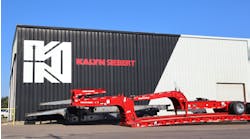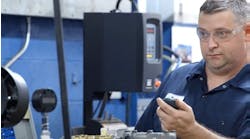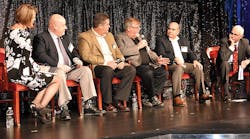The fleet panel at Heavy Duty Aftermarket Dialogue has always been illuminating because it offers real-world feedback from customers: how they maintain their business, how they maintain their equipment, the way they purchase parts, why they trade where they do, what their brand perceptions are, and variety of related issues.
Stu MacKay, president of MacKay & Company, moderated the panel for the session, “Meeting the Parts and Service Needs of Today’s Fleet.” The panel included: Brian Beaudrie, corporate vice president maintenance, Advanced Disposal; Gerry Mead, executive director of innovation, Phillips Industries, and former senior vice president of maintenance, US Xpress; Ernie Sibbick, maintenance supervisor, Keith Hall & Sons Transport LTD; and Chris Trajkovski, vice president of transportation, fleet maintenance, C&S Wholesale Grocers.
Q: Let’s talk about parts brands. Are you guys using genuine OE and if you are, at what percentage? And if you’re not, what else do you use?
Mead: We stay with genuine OE. Obviously, we use reman from the OE. When you look at where lawsuits are going today, they’ll lay down a spec and then want to know why you changed your spec. So if your spec’ing a Bendix shoe, are you putting on an aftermarket shoe on the back side? You can get into similarities and everything else, but we like to stay with OE. We did a lot of vetting of the information and negotiated pricing pretty hard. That way, we maintained our warranties and what we wanted to do from that standpoint of quality.
Sibbick: A lot of the parts are OE. We normally buy one or two and test them before we jump into that. We don’t have a line in the sand and it has to be only OEM. We try to look at what the best is. We try to buy quality. We don’t want to save $2 and have to buy it twice.
Trajkovski: We’re in transition with the asset-replacement strategy. For the new fleet, it’s 100% OE. It protects our warranty and allows us to get a stronger partnership with the OE as well. On older equipment, that wasn’t part of the asset-replacement strategy. We are using some aftermarket. We are using some alternatives. Testing and durability and reliability … we’re only so good at that, but we don’t have the technical capabilities to do a lot of that. At this point, we’re probably 75-25.
Q: We hear and read a lot about the ongoing transition between drum and air disc brake systems. How do you make a decision on what to spec in the future when it comes to brakes? Are we really at the tipping point of the adoption of disc brakes or do you see a gradual transition continuing?
Mead: To me, it becomes a two-fold question. When you look at the safety technology of today and really break down deregulation, what do you want to be? When you look at the reaction time of a driver, the amount of brake pressure that’s being applied during collision-mitigation systems, you want to stop faster. The only way to do that is to go to disc brakes. If you just stop one because of your safety specs and how you’re setting that tractor and trailer up, that pays for a whole lot of air disc brakes. Then you can break it down to easy maintenance. It’s quicker and faster and easier understood today. A truck sitting in your service bay is generating zero revenue. That’s how we judge it. Safety is first and then utilization for generating revenue. None of us are in the maintenance business. We’re all responsible for generating revenue in the long run.
Trajkovski: In 2016, tractors and trailers. Every trailer that produced in 2016 forward is 100% air disc brakes. We’re self-insured so it’s even more complicated. We still have to do our risk and liability. So there’s no feathering it in. There’s no integration. We went 100%.
Q: So you might have disc on trailer and drum still on tractor or vice versa?
Trajkovski: We actually could have both of those situations. We did try to pull as much data and information that’s in the industry. We didn’t feel there was any harm until we flushed through this replacement cycle.
Sibbick: Anything from 2012, the tractor and trailer, we’ve all gone to a disc brake. It’s proven itself. Especially the liquid haul. We do need that stop. It’s worked out well for us.
Beaudrie: You mentioned the utilization, and that’s the key. It’s being able to get in and out of the shop. And then there’s the other intangibles: roadside inspections and the fact that especially in your climate, Ernie, shoes are frozen to drums and you come in off the road. Just all the things we have to deal with. For us, it’s totally a game-changer in our organization.
Q: What are the most important features or considerations for the replacement parts you use for your fleets? Is it price? Is it brand? Is it something else?
Mead: It comes down to relationships. That comes first and foremost. Because at that point, you’re going to know that parts are going to be there. There is a lot of time when this new equipment rolls out that parts are unavailable. So when you go to buy equipment, part of that conversation has to be a full parts package that’s involved. That’s how we negotiate our deals. We’re negotiating price, and the availability goes in there. You can get your warranties, but lose it on the backside for total warranty. But upfront, they have to honor that. But in the end, you have to repair your truck with this in mind. We pay more for a higher quality product.
Q: And right down to it, including maintenance items?
Beaudrie: We look at value and quality, but safety is our #1 factor. We need to put parts on our trucks that are tested and are going to be safe. Because we can have a 67,000-pound truck but we’re running through your neighborhood with children playing in the street and homeowners walking between houses, and we never know when somebody is going to run out in front of that truck. We could not gamble on inferior parts.
Sibbick: I totally agree with those two. The best tool I learned to have years ago is communication with your sales people.
Trajkovski: I would concur with all of them. The only thing I would add is the training for technicians. I think that is part of that relationship ongoing. And then ownership. We do a corporate business review to evaluate and understand there are two priorities to every transaction. We own part of that relationship. There are many times where we’re putting the heat and pressure on the supplier and we may not be holding up our end of the deal. So we want to communicate and build a stronger relationship and call it what it really is, and being able to take action on that so that we can make that relationship stronger. We’ve exited after realizing that we can’t get to a quality level or a reliability level that we want to do with that account. You have to move on.
Q: The new costs coming out of new emissions regulations: How much has the emissions regulation and associated hardware impacted your fleet maintenance costs and how are you managing this?
Beaudrie: In refuse, I can say it’s probably almost doubled our maintenance costs on our trucks. We have such a short duty cycle going from house to house. We spend very little time on the highway, where engines have time to get hot, and burn those emissions off. So it’s really critical. Today, it’s almost transparent, but we’ve got those trucks put on the road between 2008 and 2011 that continue to be problematic. There are very high maintenance costs. We’ve all been around a long time and remember paying $400 for that turbocharger, and it lasted seven or eight years. Now you’re paying $4000 for that same turbocharger because its’s a VGT and you’re lucky if you get 18 months with it. It’s all about the emissions. It has disrupted our business. When we were starting in the refuse business in the ‘90s, our target was a 10% spare ration. For every 10 garbage trucks, we had one spare. Today, that ratio is closer to 30%. For every 10 trucks, we almost need three. Because when one goes down now, chances are it won’t be running at 8 o’clock tomorrow morning. It has to go to the dealer. It has a hardware issue, software issue. The reliability is what’s really impacted our business. It has cost us to run and keep more trucks in inventory.
Trajkovski: It has a huge impact to the carriers—the cost to acquire and maintain. As part of that risk mitigation, with the asset strategy, we have them covered from one end to the other through the ownership cycle. We have to get to a predictable R&M cost for operating that unit. And warranty was the way to go.
Mead: It went from not even on the radar to a top three cost. But you can control that based on some different PM factors we threw in. It’s actually getting better. The new engines are better at managing soot. And that’s where your oil change intervals come into play and monitoring your soot and oil, and then you can really control it. If you take apart a DPF and really look at it, it’s really more oil. Idle’s a killer. If you can manage your idle, it’s better. In refuse, I feel for you.
Q: Brian, are you a candidate for electric trucks?
Beaudrie: We’re keeping our finger on the pulse. They’re interesting. We’re not the first to jump into anything. The problem with electric trucks is the weight of the batteries. Refuse is so weight-critical. If I have 4000 pounds of batteries, that’s 4000 pounds less garbage that I can put into my truck. If we can get federal and local governments to allow us to run 4000 pounds overweight with an electrical vehicle, that’s probably something we’d consider.
Sibbick: I wish I owned a tow truck. Where I have a problem is like from Kansas City to our place costs a lot of money. The turnaround down here could be two weeks before they’ll fix it, so I might as well tow it home. I have four to five trucks at the dealership with ignition problems.









